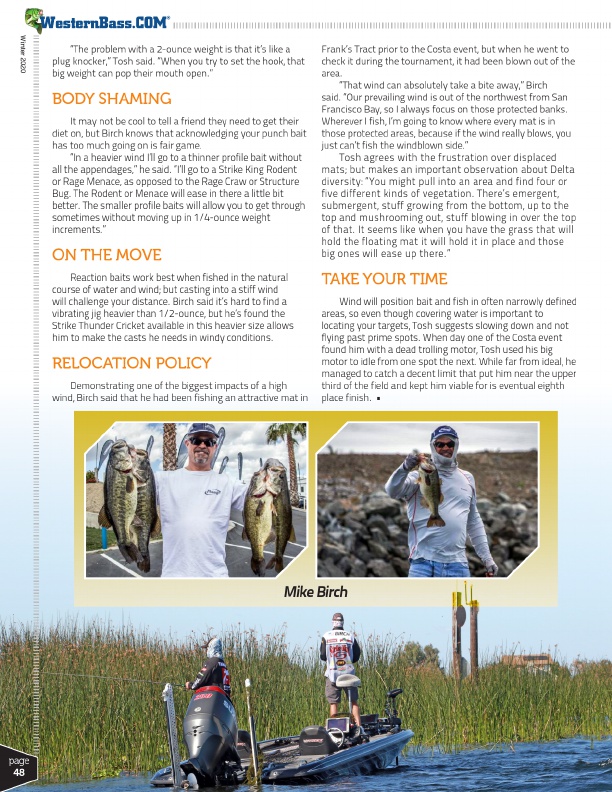
Winter 2020
®
“The problem with a 2-ounce weight is that it’s like a plug knocker,” Tosh said. “When you try to set the hook, that big weight can pop their mouth open.”
BODY SHAMING
It may not be cool to tell a friend they need to get their diet on, but Birch knows that acknowledging your punch bait has too much going on is fair game.
“In a heavier wind I’ll go to a thinner profile bait without all the appendages,” he said. “I’ll go to a Strike King Rodent or Rage Menace, as opposed to the Rage Craw or Structure Bug. The Rodent or Menace will ease in there a little bit better. The smaller profile baits will allow you to get through sometimes without moving up in 1/4-ounce weight increments.”
ON THE MOVE
Reaction baits work best when fished in the natural course of water and wind; but casting into a stiff wind will challenge your distance. Birch said it’s hard to find a vibrating jig heavier than 1/2-ounce, but he’s found the Strike Thunder Cricket available in this heavier size allows him to make the casts he needs in windy conditions.
RELOCATION POLICY
Demonstrating one of the biggest impacts of a high wind, Birch said that he had been fishing an attractive mat in
Frank’s Tract prior to the Costa event, but when he went to check it during the tournament, it had been blown out of the area.
“That wind can absolutely take a bite away,” Birch said. “Our prevailing wind is out of the northwest from San Francisco Bay, so I always focus on those protected banks. Wherever I fish, I’m going to know where every mat is in those protected areas, because if the wind really blows, you just can’t fish the windblown side.”
Tosh agrees with the frustration over displaced mats; but makes an important observation about Delta diversity: “You might pull into an area and find four or five different kinds of vegetation. There’s emergent, submergent, stuff growing from the bottom, up to the top and mushrooming out, stuff blowing in over the top of that. It seems like when you have the grass that will hold the floating mat it will hold it in place and those big ones will ease up there.”
TAKE YOUR TIME
Wind will position bait and fish in often narrowly defined areas, so even though covering water is important to locating your targets, Tosh suggests slowing down and not flying past prime spots. When day one of the Costa event found him with a dead trolling motor, Tosh used his big motor to idle from one spot the next. While far from ideal, he managed to catch a decent limit that put him near the upper third of the field and kept him viable for is eventual eighth place finish. •
Mike Birch
page 48